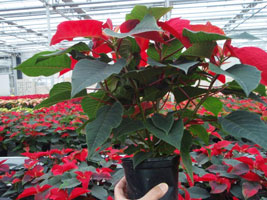10/29/2013
The Doctor is In: It’s Time for Poinsettia Trials
Dr. Ruth Kobayashi

For poinsettia growers and breeders, time is precious in November, as we work hard to bring our crops to the finish line. But it’s also a good time to do a quick review of our notes from the season’s growing and head out to a poinsettia trial or two to check out what’s new and what varieties may be good to grow next year. It’s good to do a critical evaluation of any trials you’ve conducted, as well as trials others have done to learn a little more about the varieties you’re growing this year.
Each year there are a number of universities that conduct poinsettia trials to service their regional growers and consumers. There’s also the National Poinsettia Cultivar Trial that’s a coordinated effort with four trial locations ranging from the Vineland Research Station in Ontario for the north to the University of Florida for the south to North Carolina State University and Homewood Nursery in Raleigh for the central United States.
All of the poinsettia trials have value, but for different reasons. The National Poinsettia Cultivar Trial is supported by the major poinsettia breeding companies and has a large number of varieties from the different breeders. Trials at local universities may not have all the major breeders participating, but are useful for evaluating variety performance in a location that might be more similar to your own. Trials in commercial grower operations have “real-life” value, i.e., grown with other crops, treated the same way the rest of the crop is treated, etc.
When I go to a variety trial, my objective as a breeder is to determine what’s special about any new variety. I’m there to see what’s new and interesting and I go with questions to help me objectively evaluate the varieties and the trial.
I like to start out by getting the general basic background (i.e., how the plants were grown)—what’s the schedule, growth regulator applications, natural season or lights-out, etc. I also like to get my own read on how the plants were grown by evaluating a variety with which I’m very familiar, like Prestige Red. It’s a variety I’ve had a lot of experience growing and making “mistakes” with myself and one that I’ve seen at several other growers.
We all know that a variety can look and grow differently depending upon the environment in which it was grown. A lot can be learned about what went on in the growing season by taking a few minutes to judge key characters—such as branching, flower timing, growth habit, bract and cyathia development—and compare this to how I’ve seen this variety react in different environments. I also like to know if all of the trial plants have been grown together in the greenhouse where the trial is located. One of the easiest comparisons to make is one variety to another within a trial, and I want to be careful that I’m comparing apples to apples. With this information, I have a framework for evaluating new varieties’ performances.
There seems to be just so many poinsettia varieties and the breeders keep introducing more. How can one make sense of it all? By breaking down what you see into the important component traits that you can measure objectively. For new varieties, I break down what I see into those key characters that I judged on Prestige Red when I walked in. Since my objective is to determine what’s special, I compare the traits to a familiar variety. The new variety looks different, but what about it is different? Is it the flower timing, the branching habit, the cyathia, the bracts? Does more detail help meet my objective? If not, move on to the next variety. If yes, keep observing and drilling down for more detail.
As I finish walking through a trial, I’ll have notes on traits for my familiar varieties and new varieties. Now the sea of poinsettia varieties becomes individuals with character traits that make sense to me.
You may come away excited by something new, but try to remember that a trial is just one data point. Have enthusiasm with caution—breeders are always making variety improvements; however, a variety performing well at one trial doesn’t necessarily mean it will work as well in your greenhouse. New things are fun and should be trialed—with emphasis on “trial.”
GT
Dr. Ruth Kobayashi is a Plant Breeder for the Dümmen Group.